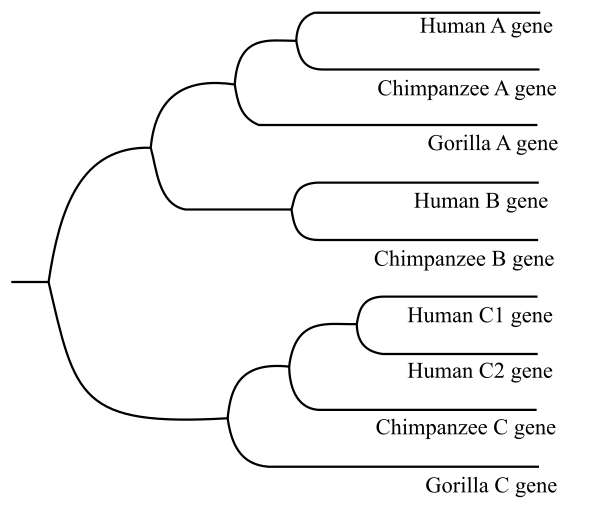
Concept explainers
To review:
The number of gene duplications and losses, which are likely to have occurred in the history of a gene family of the genomes of humans, chimpanzees, and gorillas.
Given:
The figure given below shows the gene tree derived from the genomes of humans, chimpanzee, and gorilla.

Introduction:
Gene duplication is a way in which the genomes acquire new functions. In gene duplication, one copy of the gene is made free from carrying out the original function. The gene duplication can have many outcomes. Both the genes can either retain their original function or both may have the ability to produce the original gene, but they may have the ability to diverge in different tissues at different times. One gene may become incapacitated and the other one may have the original function and the second may perform differently.
Want to see the full answer?
Check out a sample textbook solution
Chapter 23 Solutions
Life: The Science of Biology
- Would a protein encoded on the core genome or one encoded only on the pan-genome be best to use in constructing a phylogenetic tree? Explain your answerarrow_forwardConsider a recessive condition where 40% of the affected individuals pass away by the age of 10 but those that survive to adulthood are just as likely to have children as the general population. What must the new mutation rate be if the incidence of the disorder is 1/10,000 to maintain a consistent incidence across generations? Answer format: Fraction - #/#arrow_forwardYou want to make a phylogenetic tree of a group of three related species of lizards that live on an island. Their genome sequences are highly similar except for a gene that controls body size. In that region of the genome, one of the lizard species has one copy of the growth control gene (L1), the second species has a duplication of the growth control gene (L2) and the third species has three copies of the same gene (L3). The lizard species show an increase in size depending on how many copies of the growth control gene they have (L1 is smallest, L2 is medium-sized and L3 is largest). Is this enough information to determine the phylogenetic relationships between the species, and predict which of the species arrived on the island first (and is the ancestral species)? Yes, because the ancestral lizard genome probably had a single copy of the growth control gene and after arriving on the island it was duplicated, resulting in species L2, and then another duplication occurred resulting in…arrow_forward
- You compare two strands of mtDNA and discover that there are 3 differences in base pairs between them. Assuming that the mutation rate for the species that you are examining is 1 mutation every 20,000 years, how long ago did the two strands share a common ancestor? Write your answer in xxx,xxx format. These two strands shared a common ancestor _____________ years ago.arrow_forwardList three reasons why rRNA genes are suitable for phylogeneticanalyses.arrow_forwardWhat two conditions determine an organism's phenotype? Select the two best answers. RNA sequence age protein sequence environmental conditions ancestors genotypearrow_forward
- Give the Comparison of your own five Selected Genomes ?arrow_forwardCount the instances where there is any difference in the amino acid in the alignment of the six sequences and write that number below. Did you find any clades in this alignment? Describe your results. You must describe in detail the relationships between the sequences in this tree. Describe in detail how this combined tree changed the relationships between the sequences in comparison to the two separate trees that you created in the previous section abovearrow_forwardFill in the following table with the appropriate population genetics modelarrow_forward
 Human Anatomy & Physiology (11th Edition)BiologyISBN:9780134580999Author:Elaine N. Marieb, Katja N. HoehnPublisher:PEARSON
Human Anatomy & Physiology (11th Edition)BiologyISBN:9780134580999Author:Elaine N. Marieb, Katja N. HoehnPublisher:PEARSON Biology 2eBiologyISBN:9781947172517Author:Matthew Douglas, Jung Choi, Mary Ann ClarkPublisher:OpenStax
Biology 2eBiologyISBN:9781947172517Author:Matthew Douglas, Jung Choi, Mary Ann ClarkPublisher:OpenStax Anatomy & PhysiologyBiologyISBN:9781259398629Author:McKinley, Michael P., O'loughlin, Valerie Dean, Bidle, Theresa StouterPublisher:Mcgraw Hill Education,
Anatomy & PhysiologyBiologyISBN:9781259398629Author:McKinley, Michael P., O'loughlin, Valerie Dean, Bidle, Theresa StouterPublisher:Mcgraw Hill Education, Molecular Biology of the Cell (Sixth Edition)BiologyISBN:9780815344322Author:Bruce Alberts, Alexander D. Johnson, Julian Lewis, David Morgan, Martin Raff, Keith Roberts, Peter WalterPublisher:W. W. Norton & Company
Molecular Biology of the Cell (Sixth Edition)BiologyISBN:9780815344322Author:Bruce Alberts, Alexander D. Johnson, Julian Lewis, David Morgan, Martin Raff, Keith Roberts, Peter WalterPublisher:W. W. Norton & Company Laboratory Manual For Human Anatomy & PhysiologyBiologyISBN:9781260159363Author:Martin, Terry R., Prentice-craver, CynthiaPublisher:McGraw-Hill Publishing Co.
Laboratory Manual For Human Anatomy & PhysiologyBiologyISBN:9781260159363Author:Martin, Terry R., Prentice-craver, CynthiaPublisher:McGraw-Hill Publishing Co. Inquiry Into Life (16th Edition)BiologyISBN:9781260231700Author:Sylvia S. Mader, Michael WindelspechtPublisher:McGraw Hill Education
Inquiry Into Life (16th Edition)BiologyISBN:9781260231700Author:Sylvia S. Mader, Michael WindelspechtPublisher:McGraw Hill Education





